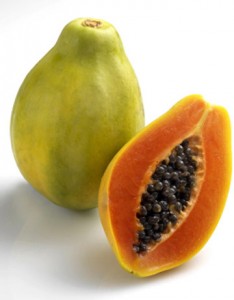The Delicious Tales of Natural Filter Media

Sterlitech Corporation prides itself in manufacturing and marketing some of the most advanced filtration products around. Our filters use materials like PTFE, PVDF, and PES, and others with inconveniently long chemical names that also make their synthetic nature really obvious. But they're not going to be the focus of this story. Instead, we will be shining a spotlight on three natural materials that, in addition to being quite tasty, make excellent filters: papayas, oysters, and coconut. Papayas Originally native to Mexico and Central America, the papaya is now grown in tropical regions around the world. The papaya is usually eaten raw when it's ripe and used in cooking when it's unripe. The seeds are edible as well, although they're surprisingly spicy. The seeds of the papaya are also the reason why papaya make such good filters. A recent study published by a group of German and Nigerian Scientists used a combination of crushed papaya seeds and kaolinite clay to create an inexpensive filtration media that excelled at adsorbing heavy metal ions out of water. The combination of inexpensiveness and effectiveness make the hybrid clay-papaya filter a promising way to give millions of people access to clean water. The original study can be found here. Oysters Like papayas, oysters can be eaten raw or cooked. Unlike papayas, the flavor of an individual oyster is strongly influenced by the quality of its surroundings. This is because oysters are filter feeders, straining nutrients, algae, and particles from the water to sustain itself. A single oyster can pass 40 gallons of water through its filters and a bed of them can improve the quality and clarity of the water immediately surrounding them. Oysters make such effective water treatment, West Palm Beach, Florida decided to use them as part of their "living dock," a waterfront development that doubles as a water filtration system. You can learn more about West Palm Beach's oyster filtration system here. Coconut Coconuts are a very versatile food; a coconut can be eaten raw, processed into oil, and its milk can be drunk straight or used in cooking. But to get at the edible portion of the coconut you have peel off its husk and break into its tough shell. The shell is the part of the coconut that is made into filters. The shells are burned to produce activated carbon, which is then built into filters for water. Coconut-based activated carbon works better than traditional coal-based activated carbon because the coconut carbon is more porous, with more surface area available to adsorb impurities out of the water. An article detailing GE's use of coconut carbon filters can be found here.
- Most Viewed Blog Articles (5)
- Company News (284)
- Emerging Technologies (64)
- Microbiology and Life Science News (93)
- Water and Fluid Separation News (97)
- Filtration Resources (93)
- Product News (19)

![Join Sterlitech at BIO 2024 [Booth #5558]: Exploring the Future of Biotechnology](https://www.sterlitech.com/media/blog/cache/300x200/magefan_blog/b4.jpeg)




